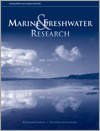Marine and Freshwater Research
Volume 72
Number 4 2021
The New Zealand Government recently proposed enforceable bottom lines to protect ecosystem health of dissolved inorganic nitrogen (1 mg L–1) and dissolved reactive phosphorus (0.018 mg L–1), but has now delayed considering them further. If all known strategies to mitigate N and P loss were implemented by 2035, the proportion of catchments exceeding these bottom lines would be 4% for DIN and 9% for DRP, meaning land use would likely change in some areas. We discuss how the use of farm environment plans and multilevel governance could change land use through output controls.
The New Zealand government has been praised for heeding scientific advice in response to the COVID-19 pandemic, but when it comes to environmental protections the scientific advice seems to be negotiable. Freshwaters have been in decline for decades despite clear science on limits needed to protect them. However, limits have been progressively weakened and not applied or enforced through agency regulatory capture and political expediency
Inland saline lakes have fewer species than do freshwater lakes. This is due mainly to salinity. Although most studies show this relationship as linear, it is scale dependent, being mediated in part by the range of salinity tolerated becoming broader as maximum tolerated salinity increases. Other factors affecting species richness include hydroperiod, habitat variability, season, pH, oxygen and, possibly, competition and predation.
The diet of the diamond stingray (Hypanus dipterurus) is based on epibenthic invertebrates, with some differences according to sex, age and season. Trophic level analysis suggests that H. dipterurus a mesopredator that does not maintain a redundant trophic function with sympatric elasmobranchs, being a key prey density-regulator functioning to link energy derived from lower to upper trophic levels within the southern Gulf of California.
Informal, social relationships are often under-recognised in river management, yet they are critical for developing and sharing specialist knowledge. This article investigated how social relationships have contributed to emergence of progressive, recovery-based rehabilitation practices. Recommendations for a relational approach to river management include recognising and supporting informal relationships, supporting cross-organisational connection, investment in social capital and providing stability while offering flexibility in institutions.
Four GAMs were used to evaluate the effect of environmental variables on the abundance of the economic species Collichthys lucidus and Lophiogobius ocellicauda in the YRE. GAM with spline ‘te’ was optimal and showed that abundance of both species was influenced by season and variables such as temperature, salinity and chlorophyll-a concentration. The determination of drivers that cause abundance fluctuations in estuarine species can guide in the development of monitoring and assessment programs for fisheries in estuarine ecosystems.
Conventional 1 year-long study is sufficient for basic data on mayfly assemblages and emergence periods. Long-term study is necessary for detailed information on population dynamics and emergence patterns. Emergence from spring habitats is mainly triggered by photoperiod. The water temperature increase signals the beginning of emergence from downstream sites. Cold-water habitats could mitigate the effect of climate change on mayfly phenology.
M. pantanalense has been described from endemic populations of M. amazonicum in Brazil. Such a description has caused taxonomical uncertainties, owing to the high morphological similarity and low genetic distance between M. amazonicum and M. pantanalense. Because of this problem, the present study aimed to carry out a hybridisation experiment between these two species to test their sexual recognition. On the basis of our results, it was possible to observe that these individuals do not copulate, and, therefore, do not generate hybrids.
Fish stocking is widely used to enhance recreational fishing and to recover depleted populations. We used otoliths (ear stones) to compare the early life growth of hatchery-produced golden perch Macquaria ambigua before being stocked and 2 years after stocking. We identified substantial variability in early life growth and provide evidence that fast-growing fish had increased survival to 2 years. We suggest that managing growth rates within the hatchery may maximise the benefits of stocking to wild fish population.
Few studies have investigated fine-scale movements of stingrays within nursery areas. Here, we examined movements in juvenile mangrove whiprays by using towed-float GPS tags within a reef-flat habitat of the Great Barrier Reef. Stingray movements were influenced by tidal height and their activity space was larger during the day. Mangrove areas were identified as primary habitats, and were likely to reduce predation risk, followed by sand patches within reef flats.
This study investigated the population structure, recruitment sources and distribution of Galaxias brevipinnis, an amphidromous fish widespread throughout Australasia. Otolith microchemistry indicated exclusive recruitment sources above and below lakes, with exclusively freshwater recruitment upstream of lakes. Furthermore, the overall abundance and relative proportion of younger fish declined as distance upstream increased, indicating recruitment limitation with distance from the pelagic larval habitat.
The mangrove species Xylocarpus granatum and Xylocarpus moluccensis had different seasonal patterns of leafing, flowering and litter production in tropical Australia. Leaf and flower production by X. moluccensis were greater where annual rainfall was lowest, whereas bud formation was greatest at sites with lower air temperatures. There were no such relationships with environmental variables for X. granatum.
This work describes the ecosystem of Florida Bay in the US, and provides support for the restoration of freshwater flows to the estuary. As one of the largest environmental efforts in the US, redirecting flows through the Everglades aims to restore natural salinity patterns in Florida Bay. Using trophic and environmental drivers, this study predicts improved resilience of Florida Bay with restored flows.
Interactions between silver gulls and humpback whales were observed off Exmouth, Western Australia. The whale’s behavioural responses were recorded from 16 interactions of gulls pecking and gouging at the skin of whales in 2018 and 2019. These results are comparable to early events of gull harassment contributing to adverse effects on southern right whales off Argentina.





